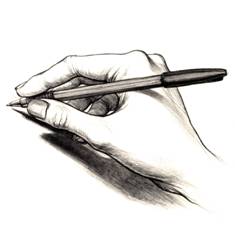 Here’s help about writing skills and autism, ADHD and other developmental delays.
Here’s help about writing skills and autism, ADHD and other developmental delays.
Given the right environment, handwriting can be fun. You may be familiar already with the Handwriting Without Tears kits, available from Therapro <www.therapyproducts.com> or 1-800-257-5376. Let’s look at four other programs designed to help children who strive to write legibly.
1) Callirobics (from CALLIgraphy and aeROBICS) is a series of simple exercises set to music. This self-guided, creative approach, devised by handwriting expert Liora Laufer, is for home or school use.
The multisensory exercises improve:
- eye-hand coordination
- fine-motor skills
- self-esteem and work habits
Many children succeed with Callirobics because the activities are brief (one to three minutes apiece), and the task of tracing abstract shapes is easily grasped. Exercises are set to appealing music such as “Danny Boy” and “London Bridge,” as well as to original melodies.
Each program comes with a workbook and audiocassette. Two levels of Callirobics are available: Pre-Writing Skills with Music (ages 4-7), and Handwriting Exercises to Music (ages 7-14).
2) Let’s Do It – Write! is a series of workbooks designed to teach children how to write legibly and quickly. The goal of author Gail Kushnir, an occupational therapist and special educator, is for children to enjoy acquiring the skills that are precursors to writing. In her workbooks, “much of the ‘work’ is really child’s play. . . which is how it should be.”
First in the series is Writing Readiness Workbook, suitable for all children beginning their schooling (K-2), for use at home, school, or clinic. Easy instructions are provided for the parent, teacher, or therapist.
Following the antics of Benjy Bear, the fun-filled prewriting exercises improve the child’s:
- sitting posture
- sensory awareness
- cutting skills
- pencil grasp
- spatial orientation
- shape formation
- problem-solving skills
Next in the series is Copying from the Board, geared to develop children’s handwriting skills. A friendly kangaroo entices the child to develop skills for copying accurately from the board. Proceeding through illustrated exercises, children have fun while developing new skills.
This program offers exercises at different levels of difficulty, practice texts for board copying, evaluation tools for educators and therapists, and sources for referral. (See DDR Booklist.)
3) Getting it Write, by occupational therapists LouAnne Audette and Anne Karson, is a remedial program for clinic or classroom use. The manual for this six-week program is dedicated to every child who has ever been told, “Don’t worry, in the future everything will be done on computers.”
The program is designed for groups of four to ten children, ages 6-12. Children with everyday handwriting difficulties or with diagnoses including learning disability, fine-motor delays, hyperactivity, or attention deficit disorder can benefit. A prerequisite is having already been taught how to form alphabet letters.
An occupational therapist and at least one other trained adult are always present throughout each one-hour class. A gym or movement area is required, as the exercises concentrate on sensory-motor skills that affect a child’s handwriting ability.
Based on a blend of occupational therapy sources, including sensory integration theory, cognitive theory, and various handwriting approaches, the program covers areas including:
- body awareness
- motor planning
- kinesthesia
- tactile discrimination
- coordinating both body sides
- memory
- visual perception
- ocular control
- fine-motor coordination
- hand strengthening
Manual materials include workbook pages, equipment lists, and lesson how-to’s, as well as forms for screening, parent intake, observation, legibility components, scoring, and post-tests.
4) Loops & Other Groups: A Kinesthetic Writing System, by Mary D. Benbow, MS, OTR/L, is a widely used handwriting curriculum. Based on studies of neurology and developmental hand anatomy, the system offers teachers a unique approach to traditional handwriting techniques. Students (2nd grade through high school) with learning disabilities and perceptual delays can learn cursive writing along with their typically developing peers in a mainstreamed classroom.
This imaginative approach makes learning fun, as students learn to form letters in groups that share common movement patterns. Memory and motor cues help students visualize and verbalize while experiencing the “feel” of the letter.
“Clock Climbers,” for instance, are the letters a, d, g, q, and c, which a child can visualize on a clock face. “Hills and Valleys” are n, m, v, y, x, and z.
An appreciative educator describes this writing system as “my instant cure for students with disabilities. . . They enjoy and excel in the area of handwriting.”
The manual includes two levels of reproducible practice sheets, alphabet models, and letter group charts. To order, contact Therapy Skillbuilders, 1-800-211-8378.
